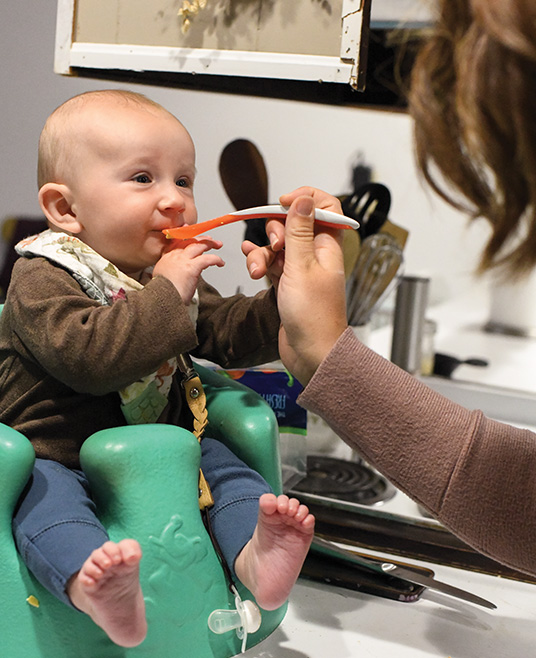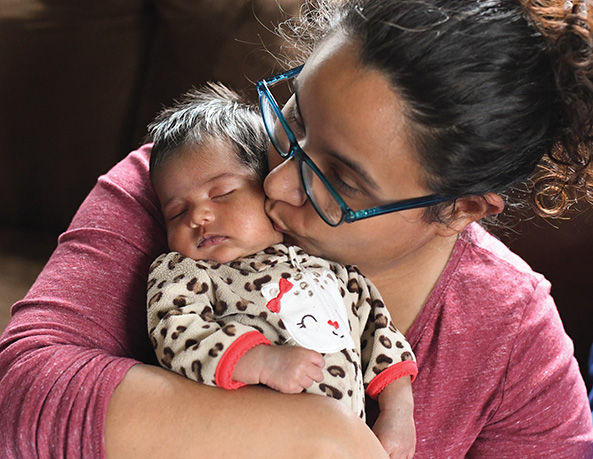
မင်္ဂလာပါ ကမ္ဘာကြီး
သားက မေမေ့ရဲ့ကလေးပါ။ မေမေက သားအတွက် အရာအားလုံးပါ။
သားရဲ့ ခန္ဓာကိုယ်၊ နှလုံးသားနဲ့ စိတ်ပိုင်းဆိုင်ရာ ဖွံ့ဖြိုးတိုးတက်အောင် သားကို ကူညီပေးပါ။ မေမေ အဲဒီလိုလုပ်ပေးတဲ့အခါ သား အကောင်းဆုံး ဖွံ့ဖြိုးတိုးတက်လာပါတယ်-
- သားကို အသားချင်းထိကပ်ပြီး ချီထားပါ ဒါမှမဟုတ် ပွေ့ဖက်ထားပါ။ မေမေ့ လက်ထဲမှာဆို စိတ်ချရတယ်လို့ ခံစားရပါတယ်။
- သားကို ပြုံးပြပြီး စကားပြောပါ။ မေမေ့ဆီကနေ သား အများကြီး သင်ယူရပါတယ်။
- မေမေ့ကို သား “စကားပြော” တဲ့အခါ နားထောင်ပေးပါ။ သား ဗိုက်ဆာ၊ ဗိုက်ပြည့်၊ နေလို့မကောင်း ဒါမှမဟုတ် ပင်ပန်းတဲ့အခါ မေမေ့ကို ပြောပြဖို့ သားရဲ့ ခန္ဓာကိုယ် လှုပ်ရှားမှုတွေနဲ့ အသံဗလံတွေကို သား အသုံးပြုရပါတယ်။
မိခင်နို့ ဒါမှမဟုတ် သံဓာတ်ပါတဲ့ ကလေးနို့မှုန့်က သားရဲ့ ပထမဆုံး 6 လအတွက် ဖွံ့ဖြိုးကြီးထွားဖို့ လိုအပ်တဲ့အရာအားလုံးပါ။

မိခင်နို့တိုက်ကျွေးခြင်း
မေမေ့မှာ သားကြီးထွားဖွံ့ဖြိုးဖို့ လိုအပ်တာတွေ ရှိပါတယ်။
- မိခင်နို့မှာ သား ကျန်းမာစွာနေဖို့နဲ့ မဖျားနာဖို့ လိုအပ်တဲ့ အာဟာရဓာတ်အားလုံး ပါရှိပါတယ်။
- မေမေ့ရဲ့ မိခင်နို့က သား ကြီးထွားလာတာနဲ့အမျှ ပြောင်းလဲလာပါတယ်။ သား မိခင်နို့ပိုစို့ရလေ ပိုကောင်းလေပါ။
သား မိခင်နို့တစ်မျိုးတည်း စို့နေရပါက ဗီတာမင်ဒီ ထပ်မံ၍ လိုအပ်သလား မေးမြန်းဖို့ သားတို့ရဲ့ ကျန်းမာရေးစောင့်ရှောက်မှု ဆရာဝန်နဲ့ တိုင်ပင်ပေးပါ။ သားအသက် 6 လသား အရွယ်မှာ သံဓာတ်ဖြည့်စွက်စာအကြောင်း မေးမြန်းပေးပါ။
ကလေးဖြည့်စွက်စာ တိုက်ကျွေးခြင်း
သား ကလေးဖြည့်စွက်စာ သောက်ရမယ်ဆိုပါက ပါဝင်ပစ္စည်းတွေကို ချက်ချင်းရောနှောဖို့က အရေးကြီးပါတယ်။ ဘူးပေါ်ရှိ ရောနှောနည်းများအတိုင်း ဆောင်ရွက်ရပါမယ်။
ဘူးထဲ ရေအရင်ဆုံးထည့်ပြီးမှ ကလေးဖြည့်စွက်စာ အမှုန့် ထည့်ရပါမယ်။
ကလေးဖြည့်စွက်စာ ဘူးထဲမှာပါတဲ့ ဇွန်းကိုသာ အမြဲ အသုံးပြုပေးပါ။ ဇွန်းအပြည့် ဖြစ်ရပါမယ်။
ရေရောပြီးသား နို့စိုအရွယ်ကလေး ကလေးဖြည့်စွက်စာကို ရေရောပြီး 2 နာရီအတွင်း အသုံးပြုပေးပါ။ ရေရောပြီး 2 နာရီအတွင်းမှာ အသုံးမပြုပါက ရေခဲသေတ္တာထဲထည့်ပြီး 24 နာရီအတွင်း သုံးပေးပါ။
စတိုက်ပြီးနောက် ဘူးထဲမှာ ကျန်တဲ့ ကလေးဖြည့်စွက်စာ အားလုံးကို 1 နာရီအကြာမှာ သွန်ပစ်လိုက်ပါ။
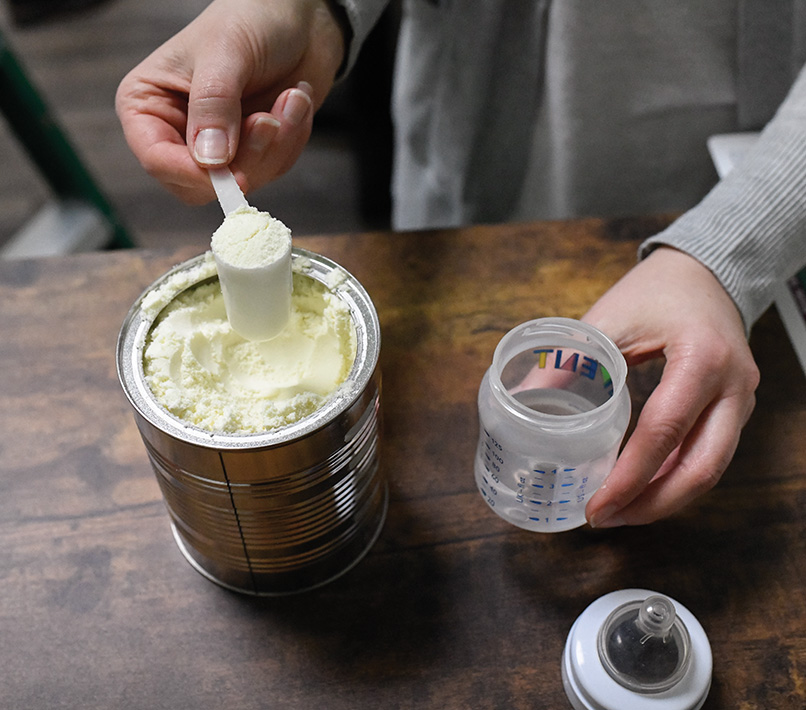

ချိန်ဆပြီး နို့ဘူးတိုက်ခြင်း
သားရဲ့ ဘူးထဲမှာ မိခင်နို့ ဒါမှမဟုတ် ကလေးဖြည့်စွက်စာ ရှိပါစေ-
- တစ်ခါတိုက်လျှင် မိခင်နို့ ဒါမှမဟုတ် ကလေးဖြည့်စွက်စာ 2 အောင်စမှ 3 အောင်စ (60-88 mL) ပမာဏဖြင့် နည်းနည်းချင်း စတိုက်ကျွေးပါ။
- ဘူးထဲကနေ သားဘာသာသား တစ်စုပ်ချင်း သောက်ခွင့်ပြုပါ။
- သား ဗိုက်ပြည့်တဲ့အခါ သား သိလာနိုင်ဖို့ သားကို ယုံကြည်ပေးပါ။ သားကို တစ်ဘူးလုံး အကုန် မသောက်ခိုင်းပါနဲ့။
- သားကို တိုက်ဖို့ အသင့်မဖြစ်သေးမချင်း ဘူးတွေကို ရေခဲသေတ္တာထဲထည့်ပြီး 24 နာရီအတွင်း သုံးပေးပါ။
- မိခင်နို့ ဒါမှမဟုတ် ကလေးဖြည့်စွက်စာ ကို မိုက်ခရိုဝေ့ဗ်နဲ့ ဘယ်တော့မှ မနွှေးပါနဲ့။ “ပူနေတဲ့နေရာတွေ” က သားရဲ့ ပါးစပ်ကို အပူလောင်စေနိုင်ပါတယ်။ အား။ အဲဒီလို လုပ်မယ့်အစား သားရဲ့ ဘူးတွေကို ရေနွေးအောက်မှာ ပူနွေးအောင်လုပ်ပေးပါ။
မေမေ့ရဲ့ ထိတွေ့မှု လိုအပ်ပါတယ်
သားကို နို့တိုက်ချိန်မှာ သားကို ချီထားပါ။
မေမေနဲ့ ရှိနေရတာကို ဘေးကင်းလုံခြုံတယ်လို့ ခံစားရပြီး မေမေ့မျက်နှာကို ကြည့်ရတာကို သဘောကျပါတယ်။
သားကို နို့တိုက်နေချိန်မှာ သားကို နိုးကြားနေအောင်ထားပါ။ သားရဲ့ဘူးကို ထောက်ကန်မထားပါနဲ့။ အဲဒါက သားကို ဆို့နင်တာ ဒါမှမဟုတ် နားကူးစက်ရောဂါ ဖြစ်စေနိုင်ပါတယ်။
သား ခဏခဏ စားဖို့ လိုအပ်ပါတယ်
သားရဲ့ အစာအိမ်လေးက သေးသေးလေးပါ။
သားရဲ့ ဗိုက်လေးက တစ်ခါစားရင် 2 အောင်စကနေ 3 အောင်စ (60-88 mL)လောက်ပဲ ဆန့်ပါတယ်။
သားက 24 နာရီအတွင်း 8 ကြိမ်ကနေ 12 ကြိမ် စားပါမယ်။
သားကို 1½ နာရီကနေ 3 နာရီကြာတိုင်း အစာကျွေးပါ။
သားရဲ့ ဗိုက်လေးက တစ်ခါစားရင် 4 အောင်စကနေ 6 အောင်စ (120-180 mL)လောက် ဆန့်ပါတယ်။
သားက 24 နာရီအတွင်း 6 ကြိမ်ကနေ 8 ကြိမ် စားပါမယ်။
ကလေးအားလုံးက ကွဲပြားကြတာကို မမေ့ပါနဲ့။ သားက ဒီနေ့ ပမာဏ တစ်မျိုး နောက်နေ့ ပမာဏတစ်မျိုး စားတတ်ပါတယ်။ သား အသက်ကြီးလာပြီး သားရဲ့ အစာအိမ် ပိုကြီးလာတာနဲ့အမျှ သား စားတဲ့ကြိမ်ရေ နည်းလာနိုင်ပေမယ့် တစ်ခါစားတိုင်း ပိုစားလာနိုင်ပါတယ်။
သားရဲ့ အမူအရာကို ကြည့်ရှုပါ
သား ဘာလိုအပ်လဲ မေမေ့ကို ပြောပြဖို့ ခန္ဓာကိုယ် လှုပ်ရှားမှုတွေကို အသုံးပြုပြီး အသံဗလံတွေ ပြုလုပ်ပါတယ်။ ဒီအရိပ်လက္ခဏာတွေကို မေမေကြည့်တတ်တယ်ဆိုရင် သား မငိုခင် မေမေ တုံ့ပြန်ပေးနိုင်ပါတယ်။ သား ငြိမ်နေတဲ့အခါ သားကို နို့တိုက်ဖို့ ပိုလွယ်ကူပါတယ်။
“ဗိုက်ဆာတယ်”
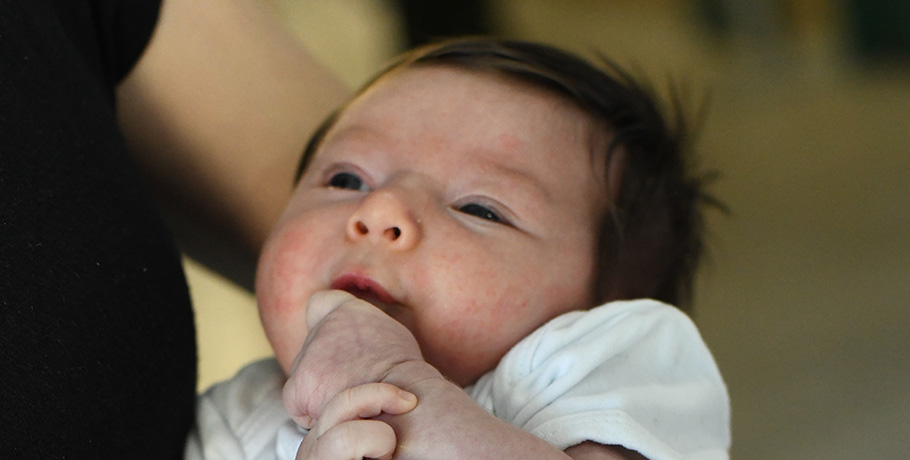
သား ဗိုက်ဆာလာပြီဆိုတာနဲ့ သားက-
- လက်တွေက ပါးစပ်ဆီ ဒါမှမဟုတ် ပါးစပ်အနီးနားကို ရောက်လာပါတယ်
- လက်တွေနဲ့ ခြေထောက်တွေ လှုပ်ပါတယ်
- စုပ်ယူတဲ့ အသံတွေ လုပ်ပါတယ်
- ပါးစပ် ဒါမှမဟုတ် လျှာ လှုပ်ပါတယ်
- ခေါင်းလှည့်တယ် ဒါမှမဟုတ် နို့သီးခေါင်း (အခြေ) ကို ရှာပါတယ်
“ဗိုက်ပြည့်ပြီ”
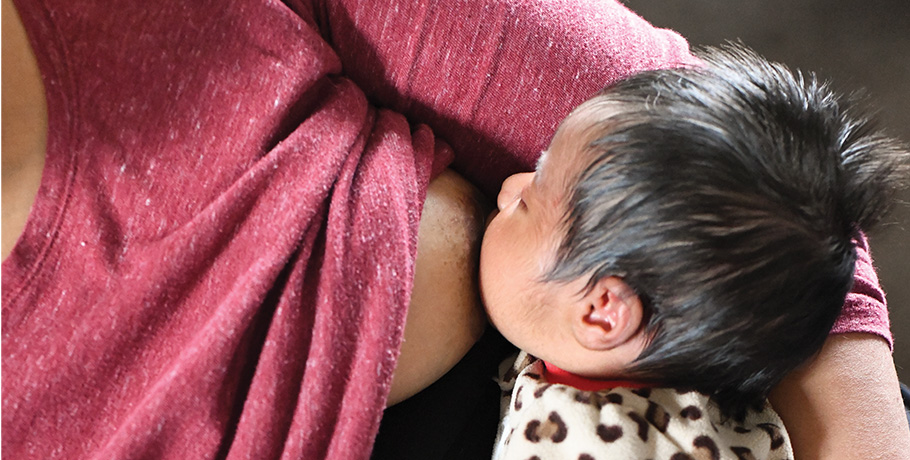
သား ဗိုက်ပြည့်လာပြီဆိုရင် သားက-
- ဖြည်းဖြည်းချင်း နို့စို့တတ်တယ် ဒါမှမဟုတ် နို့စို့တာကို ရပ်ပါတယ်
- လက်တွေနဲ့ လက်မောင်းတွေကို ဖြေလျှော့လိုက်ပါတယ်
- နို့သီးခေါင်းကနေ အဝေးသို့ လှည့်လိုက်ပါတယ်
- တွန်းထုတ်တယ်
- အိပ်ပျော်သွားသည်
- သားကို ဆက်တိုက်နေရင် မျက်မှောင်ကြုတ်တယ်၊ ကြေးများပြတယ် ဒါမှမဟုတ် ကန်ထုတ်တယ်
ရုပ်ပိုင်းဆိုင်ရာ ဖွံ့ဖြိုးကြီးထွားမှု အပြောင်းအလဲများ
သား ဖွံ့ဖြိုးလာတာနဲ့အမျှ သားရဲ့ လုပ်ရိုးလုပ်စဉ်တွေ ပြောင်းလဲလာနိုင်ပြီး ပုံမှန်ထက် ပိုအိပ်၊ ပိုစား လာနိုင်ပါတယ်။ အဲဒါတွေကို ရုပ်ပိုင်းဆိုင်ရာ ဖွံ့ဖြိုးကြီးထွားမှုတွေလို့ ခေါ်ပါတယ်။
ကလေးအားလုံးက မတူကြတာမို့ သားရဲ့ ဖွံ့ဖြိုးကြီးထွားမှုက သား ဒီအရွယ်ရောက်တဲ့အခါ ဖြစ်ပေါ်လာနိုင်ပါတယ်-

2 to 3 weeks

4 to 6 weeks

3 months

4 months

6 months

9 months
မေမေရဲ့ ခန္ဓာကိုယ်ကလည်း သား ဘာလိုအပ်လဲသိပြီး သားရဲ့ ရုပ်ပိုင်းဆိုင်ရာ ဖွံ့ဖြိုးကြီးထွားမှုတွေကို ဆက်ဖွံ့ဖြိုးစေဖို့ နို့ရည် ထုတ်ပေးပါမယ်။ မေမေ သားကို နို့ပိုတိုက်လေ ဒါမှမဟုတ် နို့ရည်ပိုထုတ်လေ မေမေ့နို့ ပိုထွက်လေပါ။
မေမေရဲ့ ခန္ဓာကိုယ်ကလည်း သား ဘာလိုအပ်လဲသိပြီး သားရဲ့ ရုပ်ပိုင်းဆိုင်ရာ ဖွံ့ဖြိုးကြီးထွားမှုတွေကို ဆက်ဖွံ့ဖြိုးစေဖို့ နို့ရည် ထုတ်ပေးပါမယ်။ မေမေ သားကို နို့ပိုတိုက်လေ ဒါမှမဟုတ် နို့ရည်ပိုထုတ်လေ မေမေ့နို့ ပိုထွက်လေပါ။
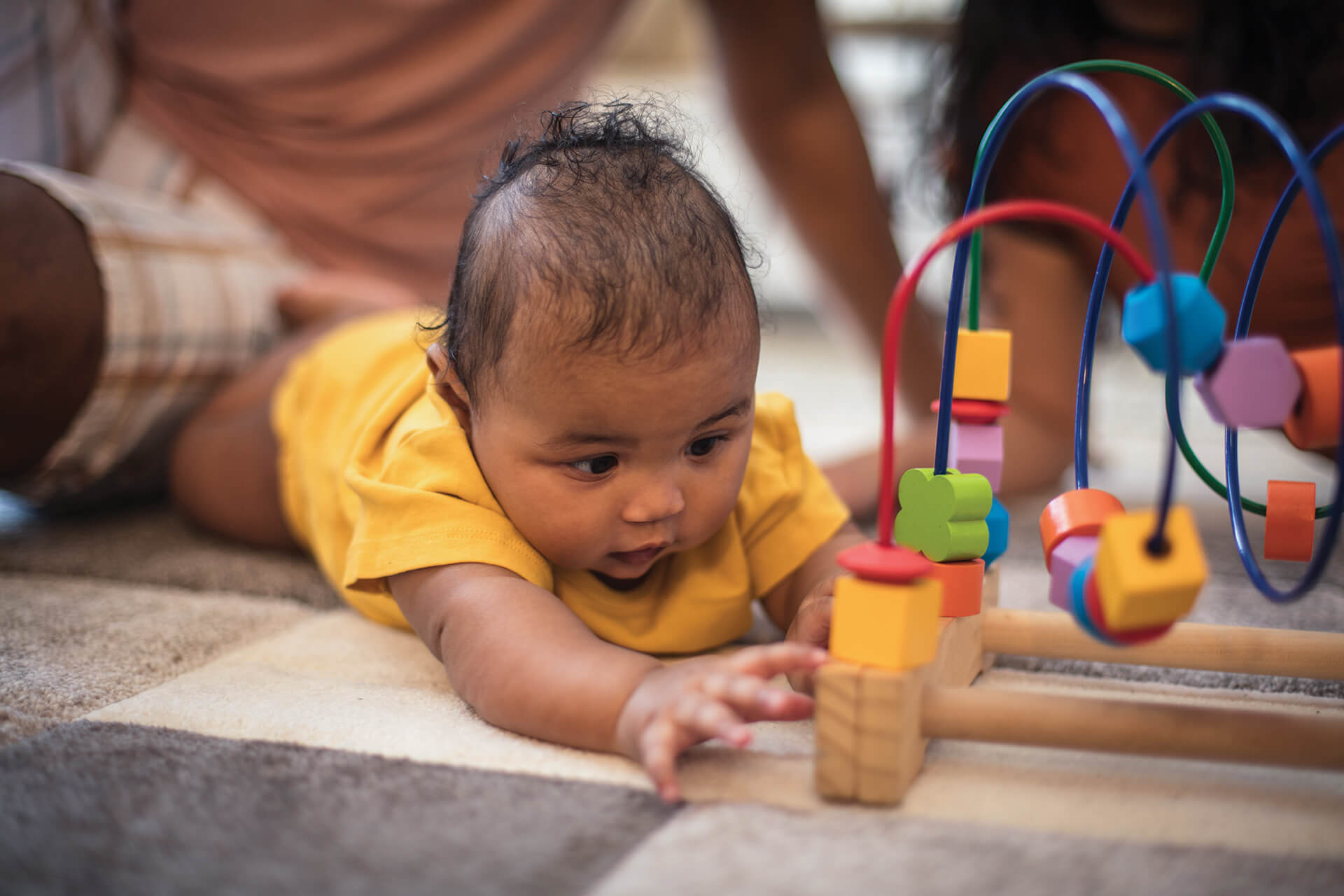
Play with me!
I’m ready to learn about you, me, and the world we live in. I want to discover what my body can do. Give me TUMMY TIME when we play. When I’m alert and relaxed, put me on a blanket on the floor. Watch how I stretch and kick my legs and move my arms. I’m making them stronger.PLAYING helps me learn, improve coordination, build strength, explore, and bond with you!

သားနဲ့တူတူ ကစားပါ။

သားက မေမေ၊ သားနဲ့ သားတို့နေတဲ့ကမ္ဘာကြီးအကြောင်း လေ့လာဖို့ အသင့်ဖြစ်ပါပြီ။
သားရဲ့ ခန္ဓာကိုယ် ဘာလုပ်နိုင်လဲဆိုတာကို လေ့လာချင်ပါတယ်။
သားတို့ ကစားတဲ့အခါ သားကို ဝမ်းလျားမှောက်ထားပေးပါ။
သား နိုးကြားပြီး ပေါ့ပါးလန်းဆန်းနေတဲ့အခါ သားကို ကြမ်းပြင်ပေါ်က စောင်ပေါ် ဝမ်းလျားမှောက်ထားပေးပါ။ သားရဲ့ခြေထောက်တွေကို ဘယ်လို ဆန့်ထုတ် ကန်ထုတ်ပြီး လက်တွေကို ဘယ်လိုလှုပ်လဲ စောင့်ကြည့်ပါ။ သားက ခြေလက်တွေ ပိုသန်မာအောင် လုပ်နေတာပါ။
- အတူကစားတာက သားကို လေ့လာနိုင်စေပါတယ်၊ ညှိနှိုင်းဆောင်ရွက်မှု တိုးတက်စေပါတယ်၊ ကြံ့ခိုင်မှု ရှိလာစေပါတယ်၊ မေမေနဲ့အတူ လေ့လာပြီး ရင်းနှီးလာနိုင်ပါတယ်။
သား ဘာလုပ်နိုင်လဲ ကြည့်လိုက်ပါ။
သား ပျော်ရွှင်ချိန်၊ အချစ်ခံရချိန်နဲ့ ဘေးကင်းစိတ်ချတဲ့အချိန်မှာ အကောင်းဆုံး ခံစားမှု ရပါတယ်။
ကမ္ဘာကြီးက သားအတွက်တော့ အသစ်အဆန်းပါ။ ကမ္ဘာကြီးက ကြောက်စရာကောင်းနိုင်ပါတယ်။ အရင်ဆုံး သား အများကြီး ငိုနိုင်ပါတယ်။
- ငိုတာက မေမေ့ကို သား လိုတယ်လို့ သား ပြောတဲ့ နည်းလမ်းပါ။
- သားတို့ အသားချင်းကပ်ပြီး ရှိချိန်မှာ သား တည်ငြိမ်ပါတယ်။ မေမေက ဂရုစိုက်တာကို သား သိရပါတယ်။
- သားကို ချီထားတာက သားကို မထိခိုက်စေပါဘူး။
- အရင်ဆုံး သားအိပ်တယ်၊ နိုးလာရင် စားတယ်၊ ပြီးရင် ပြန်အိပ်သွားပါတယ်။ ဒါက ပုံမှန်ဖြစ်ပြီး သားကို ဖွံ့ဖြိုးကြီးထွားစေပါတယ်။
- သား အသက် 3 လသားအရွယ်ပြည့်သွားတဲ့အခါ သား အချိန်ပိုကြာကြာ အိပ်လာနိုင်ပါတယ်။
- သား သင်ယူနေစဉ်မှာ သားကို စိတ်ရှည်ပေးပါ။
မေမေ့အသံကို သားသိပါတယ်။
- မေမေ စကားပြောတာကို သား ကြားချင်ပါတယ်။
သားက ပုံမှန်လုပ်ရိုးလုပ်စဉ်မှာ စတင် အခြေကျလာပါတယ်
- ညဘက်မှာ သား ပိုအိပ်လာနိုင်ပါတယ်။
သား စတင်သန်မာလာပြီး တက်ကြွဖျတ်လတ်လာပါတယ်။
- သားရဲ့ခေါင်းကို သားထိန်းလာနိုင်ပါပြီ။
- သားကို နာမည်ခေါ်လိုက်ရင် သား သိလာပါပြီ။
- တီတီတာတာ သားပြောလာနိုင်ပါပြီ။
- သား ရယ်တတ်လာပါပြီ။
- သားနဲ့အတူ တူတူရေဝါးနဲ့ ကိတ်မုန့်ဖုတ်တမ်း ကစားရအောင်။
သားကို စာဖတ်ပြပါ။
- သားကို ပုံတွေ ပြပြီး ပုံထဲက လူတွေအကြောင်း ပြောပြပါ။
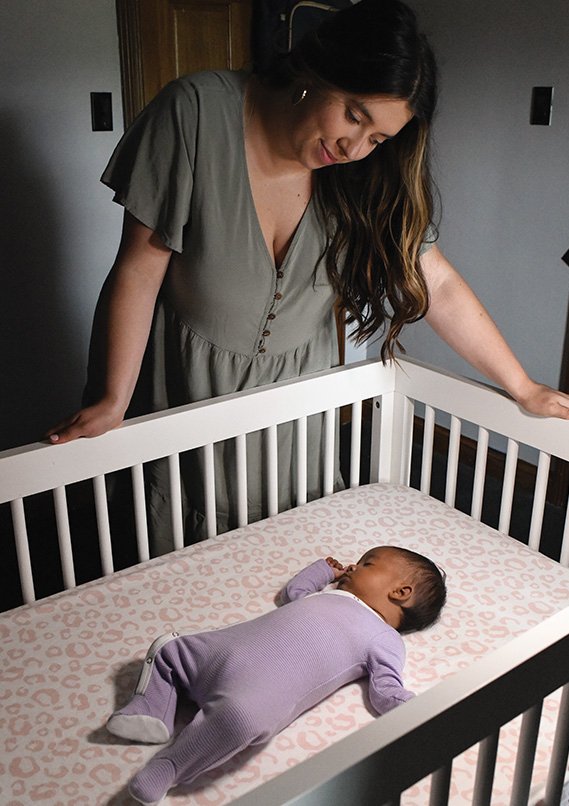
သားကို ဘေးကင်း ကျန်းမာစွာထားပါ
- သားကို သားရဲ့ ကလေးအိပ်ရာ ဒါမှမဟုတ် ပုခက်ထဲမှာ အမြဲတမ်း တစ်ယောက်တည်း ကျောချပြီး အိပ်ခိုင်းပါ။ သားတို့ တစ်ခန်းတည်းမှာ အိပ်လို့ရပေမယ့် တစ်ခုတင်ထဲတော့ မအိပ်သင့်ပါဘူး။ စောင်၊ ခေါင်းအုံး ဒါမှမဟုတ် အရုပ်တွေက သားရဲ့ ပါးစပ် ဒါမှမဟုတ် နှာခေါင်းကို ဖုံးအုပ်မိတဲ့အခါ သား အသက်ရှူကျပ်နိုင်ပါတယ်။
- အစားအစာ တစ်ခုခု မစီမံခင်နဲ့ သားကို မကျွေးမွေးခင် မေမေ့လက်တွေကို ဆေးကြောပါ။
- သား စားပြီးတဲ့နောက် အထူးသဖြင့် အိပ်ရာမဝင်ခင် သားရဲ့ သွားဖုံးတွေကို သန့်ရှင်း၊ နူးညံ့ပြီး စိုစွတ်တဲ့ အဝတ်နဲ့ ပွတ်ပေးပါ။
- အစားအစာ အဖတ်တွေကို သားကို မကျွေးခင် သား အသက် 6 လသားခန့်အထိ စောင့်ပေးပါ။ သားရဲ့ ကိုယ်ခံအားစနစ် တိုးတက်လာဖို့နဲ့ အစာစားဖို့နဲ့ အစားအစာတွေကို စနစ်တကျ မျိုချဖို့ သားရဲ့ ပါးစပ်ထဲက ကြွက်သားတွေ သန်မာလာဖို့ အချိန်လိုပါတယ်။ သား အသင့်မဖြစ်ခင် သားကို အစားအစာ အဖတ်တွေ ကျွေးမယ်ဆိုရင် သား ဆို့နင် ဒါမှမဟုတ် ဖျားသွားနိုင်ပါတယ်။
- သားတို့ မိသားစု ကျန်းမာဘေးကင်းနေစေဖို့ ဆေးရွက်ကြီး ဒါမှမဟုတ် နီကိုတင်း ထုတ်ကုန်များ၊ အရက်၊ ဆေးခြောက်နဲ့ အခြား တရားမဝင် မူးယစ်ဆေးသုံးစွဲမှုကို ရှောင်ပါ။ ဆေးရွက်ကြီး သို့မဟုတ် နီကိုတင်း ထုတ်ကုန်များ ဖြတ်ခြင်းဆိုင်ရာ အကူအညီအတွက် www.quitnow.net. သို့ ဝင်ကြည့်ပါ။ အရက် သို့မဟုတ် အခြားဆေးဝါးများ ဖြတ်ခြင်းဆိုင်ရာ အကူအညီအတွက် www.findtreatment.gov သို့ ဝင်ကြည့်ပါ။ သင်၏ Special Supplemental Nutrition Program for Women, Infants and Children (WIC, အမျိူးသမီးများ၊ နို့စို့ကလေးများနှင့် ကလေးငယ်များအတွက် အထူးဖြည့်စွက်အာဟာရ ထောက်ပံ့မှု အစီအစဥ်) အာဟာရဗေဒပညာရှင်ကလည်း အပိုဆောင်းရင်းမြစ်များ ထုတ်ပေးနိုင်ပါသည်။
DON’T let me have these foods until I am at least 1 year old:
Cow’s milk or other non-dairy milks (like soy or almond milk). It’s too hard for me to digest and may cause health problems.
Honey and foods made with honey. Honey can contain bacteria that cause infant botulism, or food poisoning. These bacteria are harmless to older kids and adults.
Introducing Peanut Butter
If my healthcare provider says it is ok, let me try peanut butter around 6 months of age. Doing this might help prevent a peanut allergy as I grow older.
In the morning, mix one teaspoon of peanut butter with human milk or formula. Make it thin and easy to swallow.
Use a spoon to offer a taste of the thinned product. Wait 10 minutes, then offer more. Watch for any reaction for the next 2 hours.
